Adult Health Care: New Zealand and India Life Expectancy Strategies
VerifiedAdded on 2020/05/11
|14
|3000
|114
Report
AI Summary
This report provides a comparative analysis of life expectancy between New Zealand and India, examining the factors that influence it, such as gender, genetics, socio-economic status, education, ethnicity, lifestyle, medical technology, and marital status. It delves into the specific health strategies of each nation, including New Zealand's He Korowai Oranga: Māori Health Strategy and India's universal health coverage theme. The report highlights the health status and conditions in both countries, access to healthcare, and the background and goals of the respective strategies. A key focus is on contrasting the approaches and outcomes of the two countries' public health policies, offering insights into the successes and challenges of improving life expectancy and overall population health. The report concludes with a comparison of the strategies, highlighting the differences in approaches.
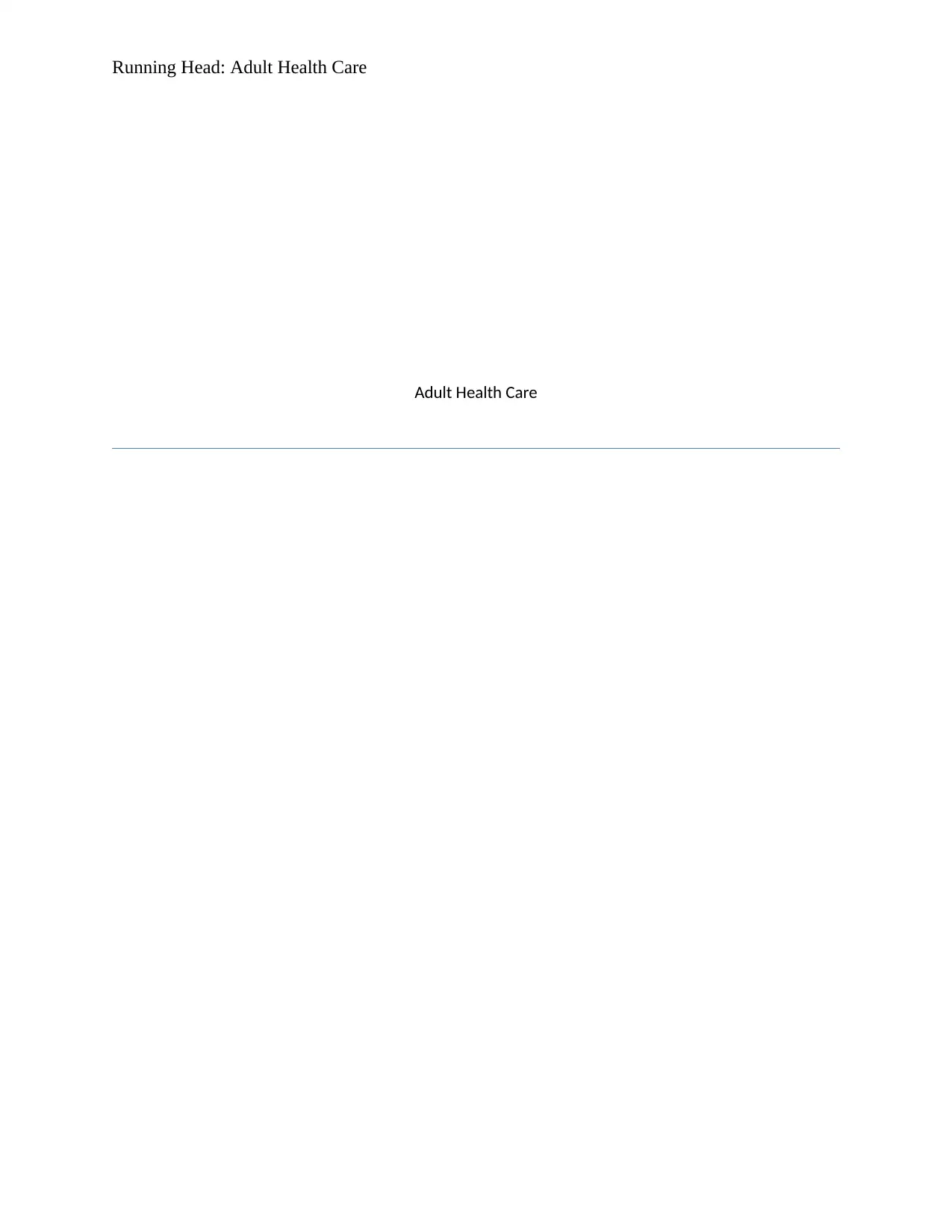
Running Head: Adult Health Care
Adult Health Care
Adult Health Care
Paraphrase This Document
Need a fresh take? Get an instant paraphrase of this document with our AI Paraphraser
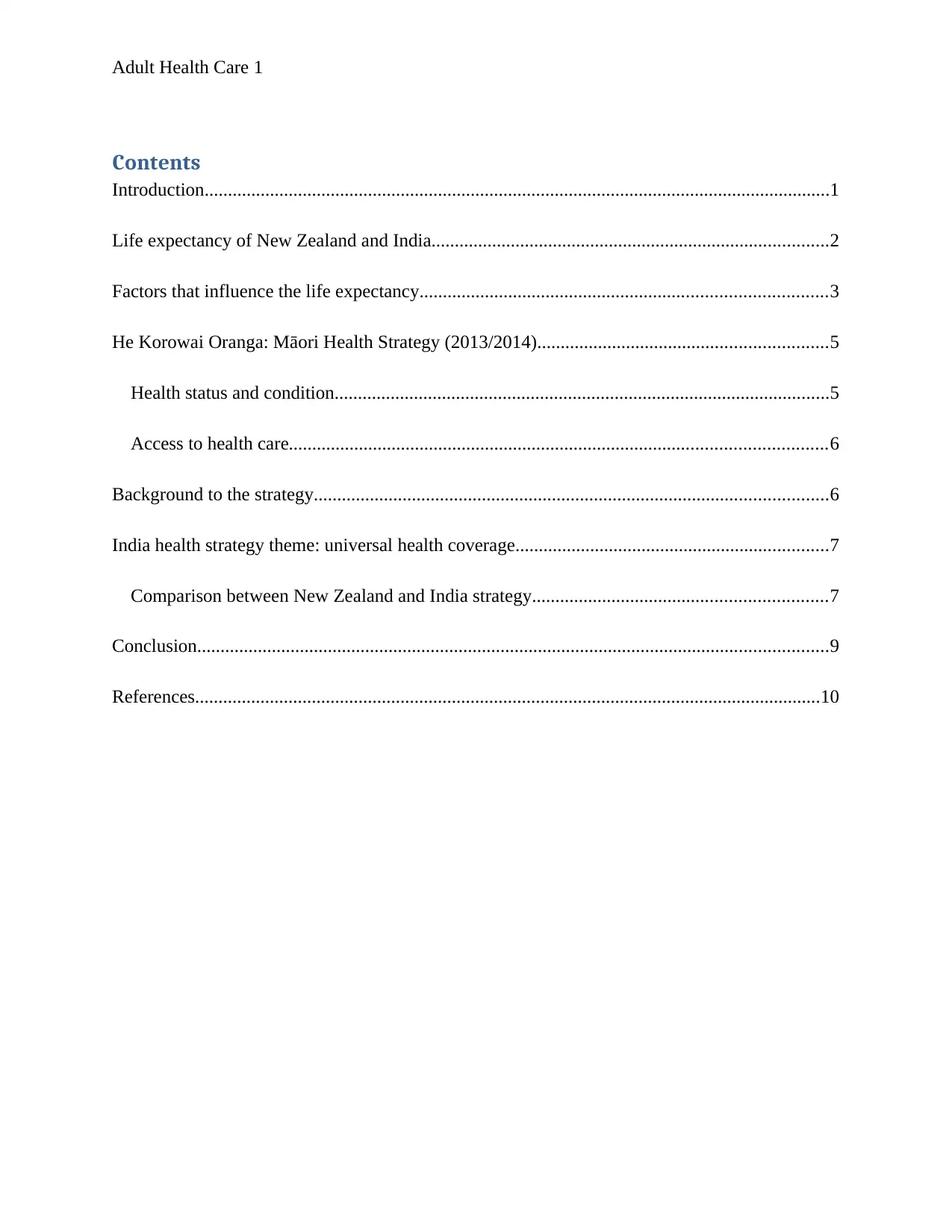
Adult Health Care 1
Contents
Introduction......................................................................................................................................1
Life expectancy of New Zealand and India.....................................................................................2
Factors that influence the life expectancy.......................................................................................3
He Korowai Oranga: Māori Health Strategy (2013/2014)..............................................................5
Health status and condition..........................................................................................................5
Access to health care...................................................................................................................6
Background to the strategy..............................................................................................................6
India health strategy theme: universal health coverage...................................................................7
Comparison between New Zealand and India strategy...............................................................7
Conclusion.......................................................................................................................................9
References......................................................................................................................................10
Contents
Introduction......................................................................................................................................1
Life expectancy of New Zealand and India.....................................................................................2
Factors that influence the life expectancy.......................................................................................3
He Korowai Oranga: Māori Health Strategy (2013/2014)..............................................................5
Health status and condition..........................................................................................................5
Access to health care...................................................................................................................6
Background to the strategy..............................................................................................................6
India health strategy theme: universal health coverage...................................................................7
Comparison between New Zealand and India strategy...............................................................7
Conclusion.......................................................................................................................................9
References......................................................................................................................................10
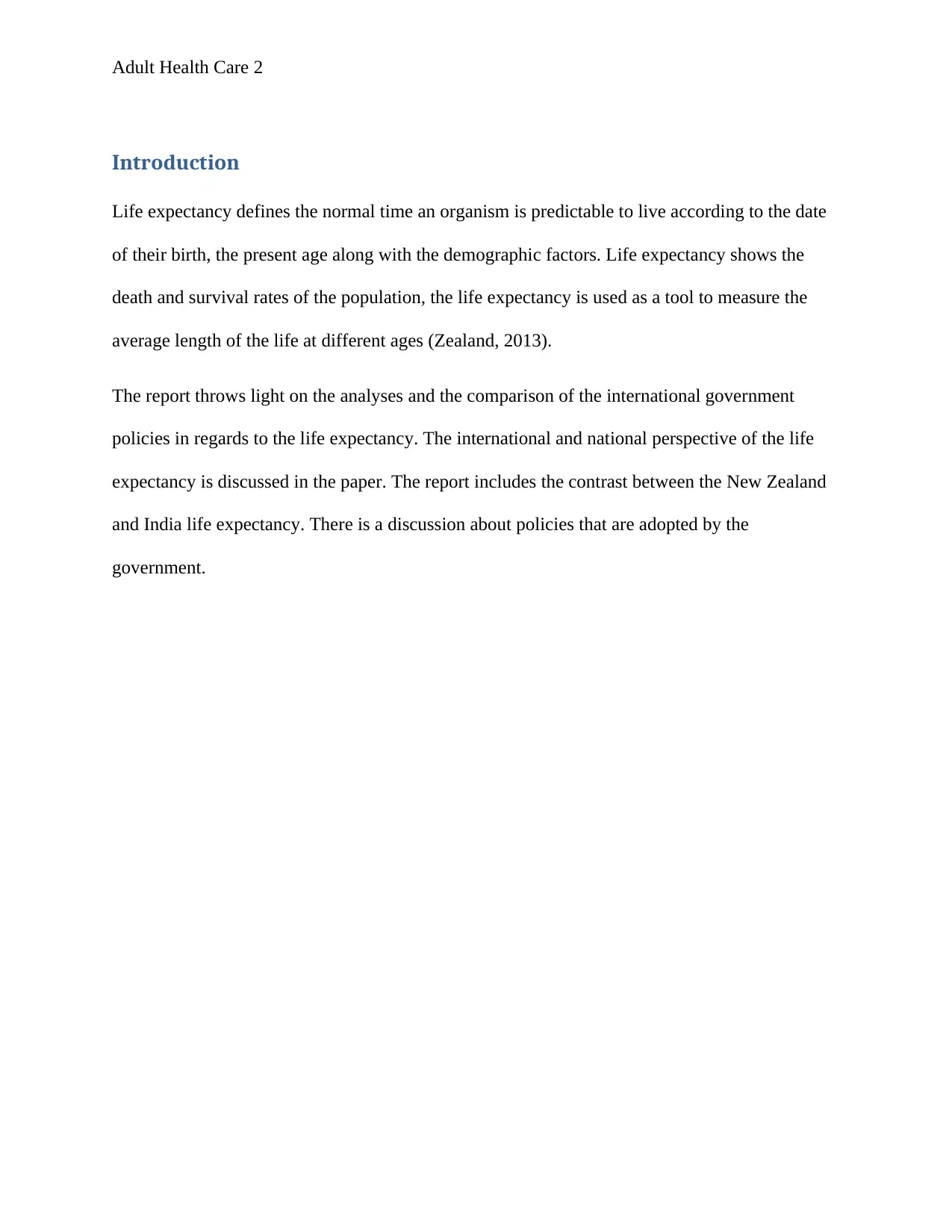
Adult Health Care 2
Introduction
Life expectancy defines the normal time an organism is predictable to live according to the date
of their birth, the present age along with the demographic factors. Life expectancy shows the
death and survival rates of the population, the life expectancy is used as a tool to measure the
average length of the life at different ages (Zealand, 2013).
The report throws light on the analyses and the comparison of the international government
policies in regards to the life expectancy. The international and national perspective of the life
expectancy is discussed in the paper. The report includes the contrast between the New Zealand
and India life expectancy. There is a discussion about policies that are adopted by the
government.
Introduction
Life expectancy defines the normal time an organism is predictable to live according to the date
of their birth, the present age along with the demographic factors. Life expectancy shows the
death and survival rates of the population, the life expectancy is used as a tool to measure the
average length of the life at different ages (Zealand, 2013).
The report throws light on the analyses and the comparison of the international government
policies in regards to the life expectancy. The international and national perspective of the life
expectancy is discussed in the paper. The report includes the contrast between the New Zealand
and India life expectancy. There is a discussion about policies that are adopted by the
government.
⊘ This is a preview!⊘
Do you want full access?
Subscribe today to unlock all pages.

Trusted by 1+ million students worldwide
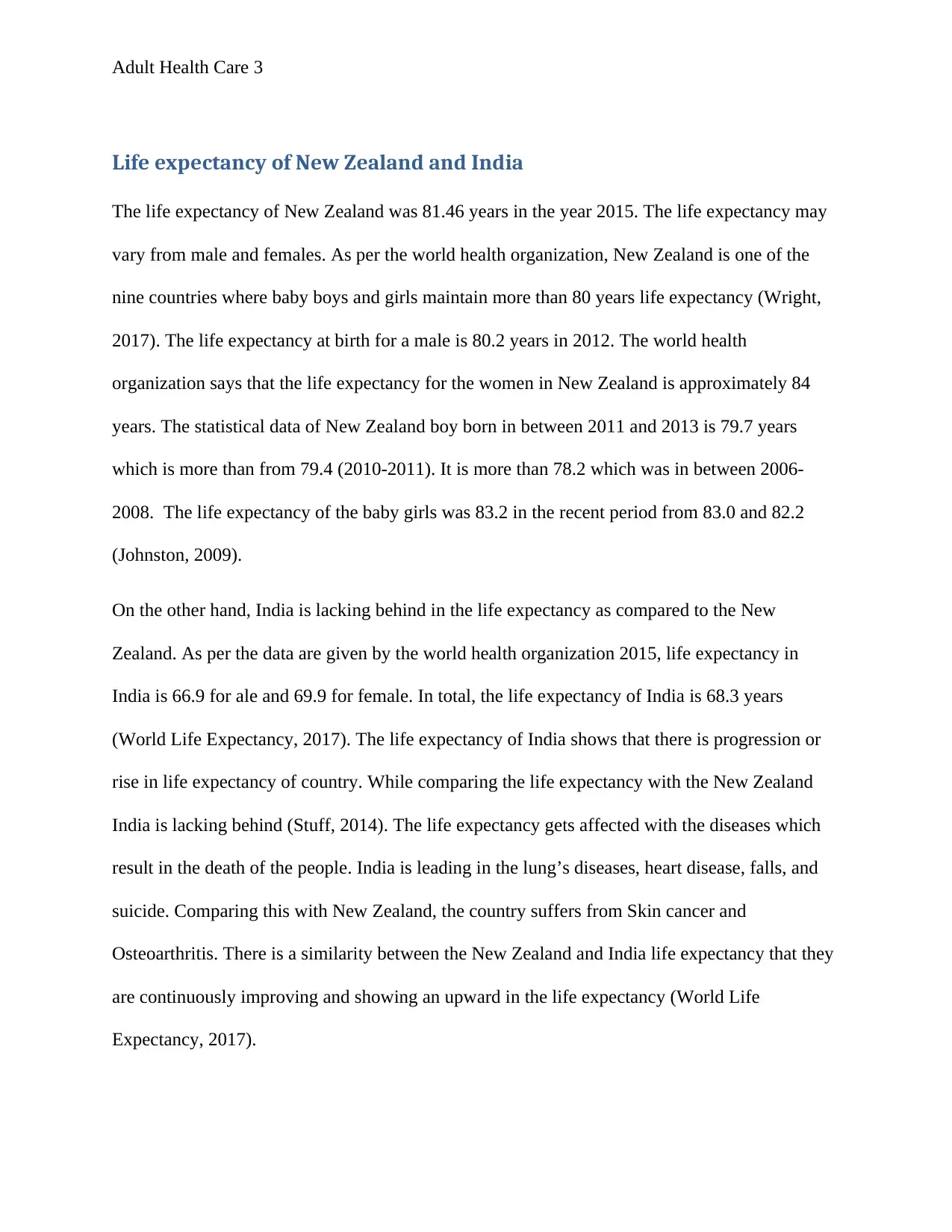
Adult Health Care 3
Life expectancy of New Zealand and India
The life expectancy of New Zealand was 81.46 years in the year 2015. The life expectancy may
vary from male and females. As per the world health organization, New Zealand is one of the
nine countries where baby boys and girls maintain more than 80 years life expectancy (Wright,
2017). The life expectancy at birth for a male is 80.2 years in 2012. The world health
organization says that the life expectancy for the women in New Zealand is approximately 84
years. The statistical data of New Zealand boy born in between 2011 and 2013 is 79.7 years
which is more than from 79.4 (2010-2011). It is more than 78.2 which was in between 2006-
2008. The life expectancy of the baby girls was 83.2 in the recent period from 83.0 and 82.2
(Johnston, 2009).
On the other hand, India is lacking behind in the life expectancy as compared to the New
Zealand. As per the data are given by the world health organization 2015, life expectancy in
India is 66.9 for ale and 69.9 for female. In total, the life expectancy of India is 68.3 years
(World Life Expectancy, 2017). The life expectancy of India shows that there is progression or
rise in life expectancy of country. While comparing the life expectancy with the New Zealand
India is lacking behind (Stuff, 2014). The life expectancy gets affected with the diseases which
result in the death of the people. India is leading in the lung’s diseases, heart disease, falls, and
suicide. Comparing this with New Zealand, the country suffers from Skin cancer and
Osteoarthritis. There is a similarity between the New Zealand and India life expectancy that they
are continuously improving and showing an upward in the life expectancy (World Life
Expectancy, 2017).
Life expectancy of New Zealand and India
The life expectancy of New Zealand was 81.46 years in the year 2015. The life expectancy may
vary from male and females. As per the world health organization, New Zealand is one of the
nine countries where baby boys and girls maintain more than 80 years life expectancy (Wright,
2017). The life expectancy at birth for a male is 80.2 years in 2012. The world health
organization says that the life expectancy for the women in New Zealand is approximately 84
years. The statistical data of New Zealand boy born in between 2011 and 2013 is 79.7 years
which is more than from 79.4 (2010-2011). It is more than 78.2 which was in between 2006-
2008. The life expectancy of the baby girls was 83.2 in the recent period from 83.0 and 82.2
(Johnston, 2009).
On the other hand, India is lacking behind in the life expectancy as compared to the New
Zealand. As per the data are given by the world health organization 2015, life expectancy in
India is 66.9 for ale and 69.9 for female. In total, the life expectancy of India is 68.3 years
(World Life Expectancy, 2017). The life expectancy of India shows that there is progression or
rise in life expectancy of country. While comparing the life expectancy with the New Zealand
India is lacking behind (Stuff, 2014). The life expectancy gets affected with the diseases which
result in the death of the people. India is leading in the lung’s diseases, heart disease, falls, and
suicide. Comparing this with New Zealand, the country suffers from Skin cancer and
Osteoarthritis. There is a similarity between the New Zealand and India life expectancy that they
are continuously improving and showing an upward in the life expectancy (World Life
Expectancy, 2017).
Paraphrase This Document
Need a fresh take? Get an instant paraphrase of this document with our AI Paraphraser
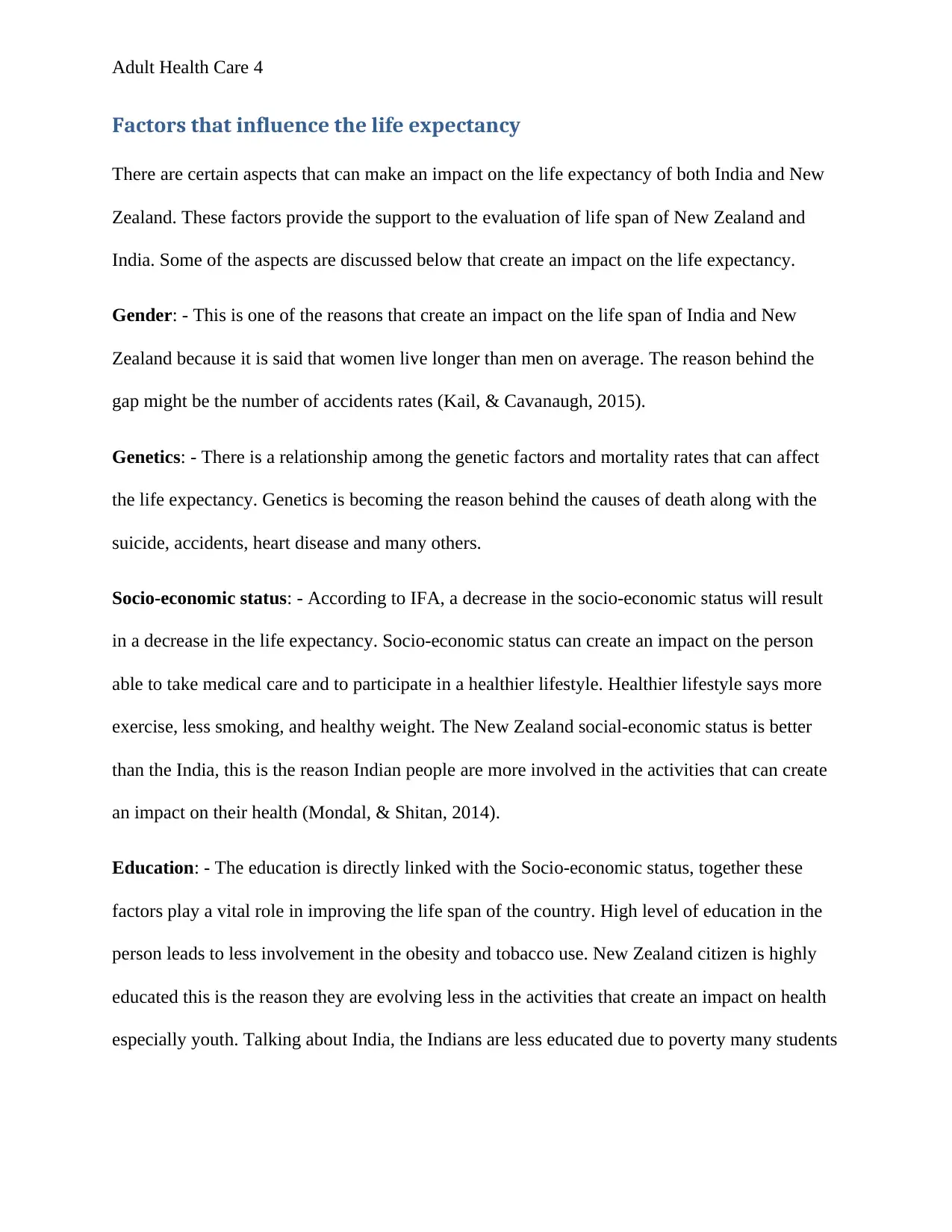
Adult Health Care 4
Factors that influence the life expectancy
There are certain aspects that can make an impact on the life expectancy of both India and New
Zealand. These factors provide the support to the evaluation of life span of New Zealand and
India. Some of the aspects are discussed below that create an impact on the life expectancy.
Gender: - This is one of the reasons that create an impact on the life span of India and New
Zealand because it is said that women live longer than men on average. The reason behind the
gap might be the number of accidents rates (Kail, & Cavanaugh, 2015).
Genetics: - There is a relationship among the genetic factors and mortality rates that can affect
the life expectancy. Genetics is becoming the reason behind the causes of death along with the
suicide, accidents, heart disease and many others.
Socio-economic status: - According to IFA, a decrease in the socio-economic status will result
in a decrease in the life expectancy. Socio-economic status can create an impact on the person
able to take medical care and to participate in a healthier lifestyle. Healthier lifestyle says more
exercise, less smoking, and healthy weight. The New Zealand social-economic status is better
than the India, this is the reason Indian people are more involved in the activities that can create
an impact on their health (Mondal, & Shitan, 2014).
Education: - The education is directly linked with the Socio-economic status, together these
factors play a vital role in improving the life span of the country. High level of education in the
person leads to less involvement in the obesity and tobacco use. New Zealand citizen is highly
educated this is the reason they are evolving less in the activities that create an impact on health
especially youth. Talking about India, the Indians are less educated due to poverty many students
Factors that influence the life expectancy
There are certain aspects that can make an impact on the life expectancy of both India and New
Zealand. These factors provide the support to the evaluation of life span of New Zealand and
India. Some of the aspects are discussed below that create an impact on the life expectancy.
Gender: - This is one of the reasons that create an impact on the life span of India and New
Zealand because it is said that women live longer than men on average. The reason behind the
gap might be the number of accidents rates (Kail, & Cavanaugh, 2015).
Genetics: - There is a relationship among the genetic factors and mortality rates that can affect
the life expectancy. Genetics is becoming the reason behind the causes of death along with the
suicide, accidents, heart disease and many others.
Socio-economic status: - According to IFA, a decrease in the socio-economic status will result
in a decrease in the life expectancy. Socio-economic status can create an impact on the person
able to take medical care and to participate in a healthier lifestyle. Healthier lifestyle says more
exercise, less smoking, and healthy weight. The New Zealand social-economic status is better
than the India, this is the reason Indian people are more involved in the activities that can create
an impact on their health (Mondal, & Shitan, 2014).
Education: - The education is directly linked with the Socio-economic status, together these
factors play a vital role in improving the life span of the country. High level of education in the
person leads to less involvement in the obesity and tobacco use. New Zealand citizen is highly
educated this is the reason they are evolving less in the activities that create an impact on health
especially youth. Talking about India, the Indians are less educated due to poverty many students
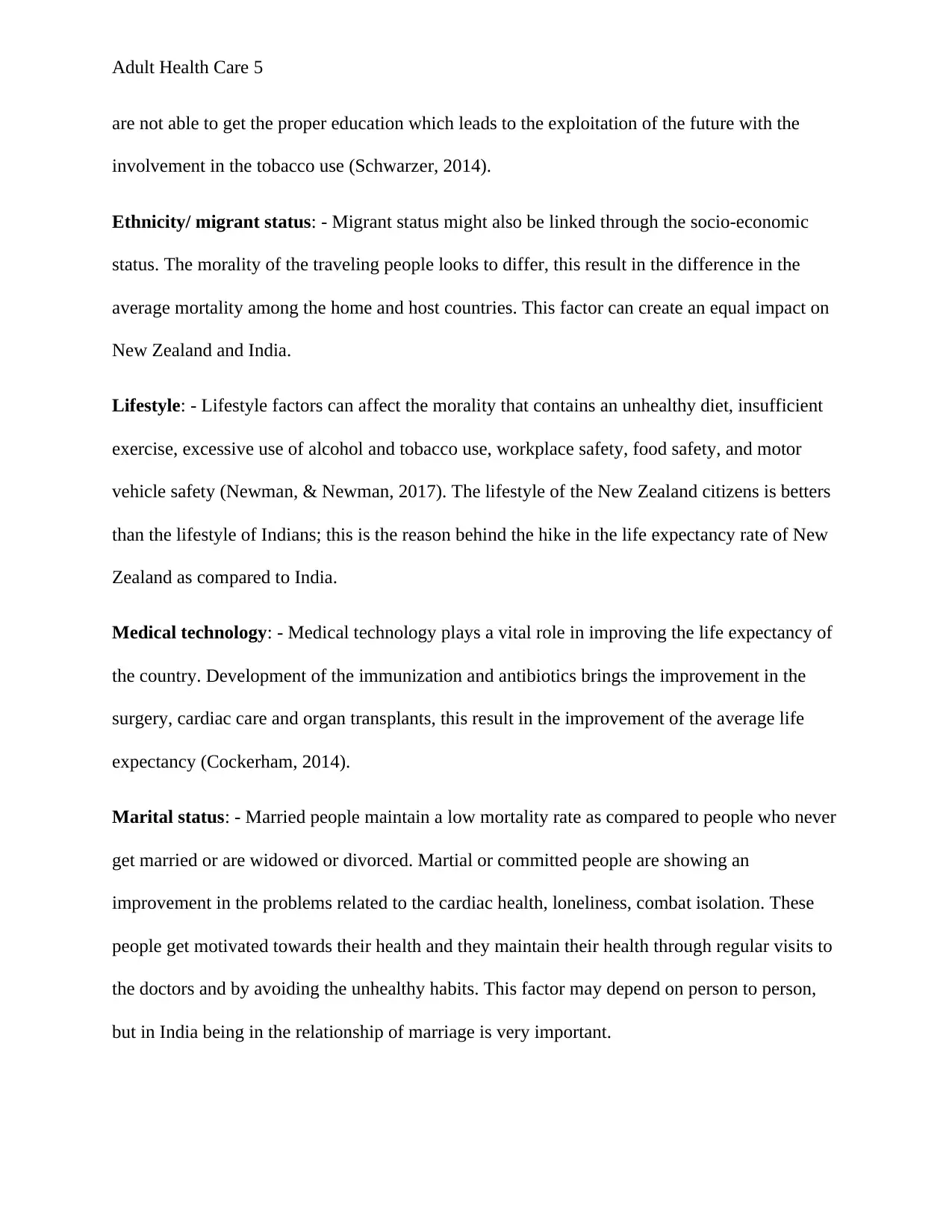
Adult Health Care 5
are not able to get the proper education which leads to the exploitation of the future with the
involvement in the tobacco use (Schwarzer, 2014).
Ethnicity/ migrant status: - Migrant status might also be linked through the socio-economic
status. The morality of the traveling people looks to differ, this result in the difference in the
average mortality among the home and host countries. This factor can create an equal impact on
New Zealand and India.
Lifestyle: - Lifestyle factors can affect the morality that contains an unhealthy diet, insufficient
exercise, excessive use of alcohol and tobacco use, workplace safety, food safety, and motor
vehicle safety (Newman, & Newman, 2017). The lifestyle of the New Zealand citizens is betters
than the lifestyle of Indians; this is the reason behind the hike in the life expectancy rate of New
Zealand as compared to India.
Medical technology: - Medical technology plays a vital role in improving the life expectancy of
the country. Development of the immunization and antibiotics brings the improvement in the
surgery, cardiac care and organ transplants, this result in the improvement of the average life
expectancy (Cockerham, 2014).
Marital status: - Married people maintain a low mortality rate as compared to people who never
get married or are widowed or divorced. Martial or committed people are showing an
improvement in the problems related to the cardiac health, loneliness, combat isolation. These
people get motivated towards their health and they maintain their health through regular visits to
the doctors and by avoiding the unhealthy habits. This factor may depend on person to person,
but in India being in the relationship of marriage is very important.
are not able to get the proper education which leads to the exploitation of the future with the
involvement in the tobacco use (Schwarzer, 2014).
Ethnicity/ migrant status: - Migrant status might also be linked through the socio-economic
status. The morality of the traveling people looks to differ, this result in the difference in the
average mortality among the home and host countries. This factor can create an equal impact on
New Zealand and India.
Lifestyle: - Lifestyle factors can affect the morality that contains an unhealthy diet, insufficient
exercise, excessive use of alcohol and tobacco use, workplace safety, food safety, and motor
vehicle safety (Newman, & Newman, 2017). The lifestyle of the New Zealand citizens is betters
than the lifestyle of Indians; this is the reason behind the hike in the life expectancy rate of New
Zealand as compared to India.
Medical technology: - Medical technology plays a vital role in improving the life expectancy of
the country. Development of the immunization and antibiotics brings the improvement in the
surgery, cardiac care and organ transplants, this result in the improvement of the average life
expectancy (Cockerham, 2014).
Marital status: - Married people maintain a low mortality rate as compared to people who never
get married or are widowed or divorced. Martial or committed people are showing an
improvement in the problems related to the cardiac health, loneliness, combat isolation. These
people get motivated towards their health and they maintain their health through regular visits to
the doctors and by avoiding the unhealthy habits. This factor may depend on person to person,
but in India being in the relationship of marriage is very important.
⊘ This is a preview!⊘
Do you want full access?
Subscribe today to unlock all pages.

Trusted by 1+ million students worldwide
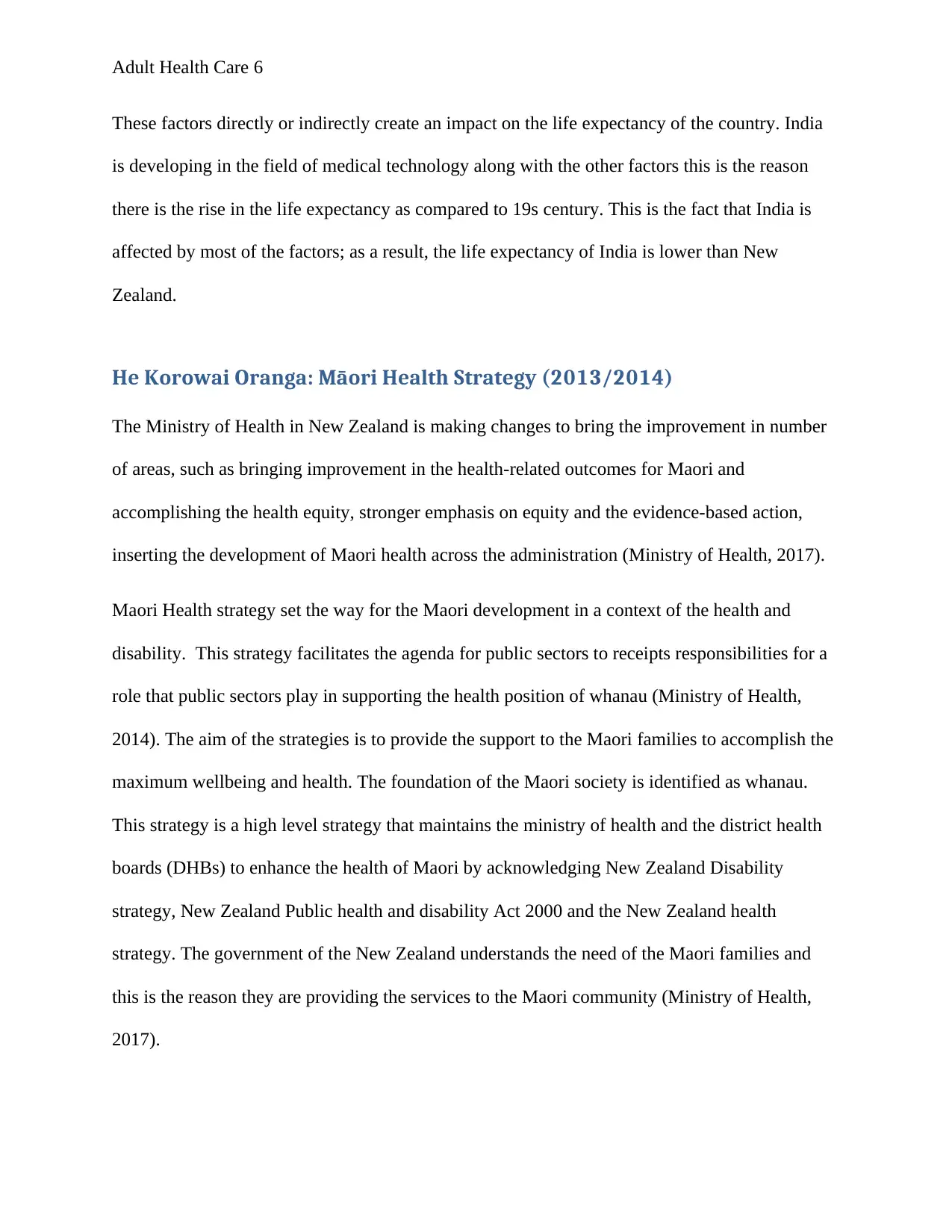
Adult Health Care 6
These factors directly or indirectly create an impact on the life expectancy of the country. India
is developing in the field of medical technology along with the other factors this is the reason
there is the rise in the life expectancy as compared to 19s century. This is the fact that India is
affected by most of the factors; as a result, the life expectancy of India is lower than New
Zealand.
He Korowai Oranga: Māori Health Strategy (2013/2014)
The Ministry of Health in New Zealand is making changes to bring the improvement in number
of areas, such as bringing improvement in the health-related outcomes for Maori and
accomplishing the health equity, stronger emphasis on equity and the evidence-based action,
inserting the development of Maori health across the administration (Ministry of Health, 2017).
Maori Health strategy set the way for the Maori development in a context of the health and
disability. This strategy facilitates the agenda for public sectors to receipts responsibilities for a
role that public sectors play in supporting the health position of whanau (Ministry of Health,
2014). The aim of the strategies is to provide the support to the Maori families to accomplish the
maximum wellbeing and health. The foundation of the Maori society is identified as whanau.
This strategy is a high level strategy that maintains the ministry of health and the district health
boards (DHBs) to enhance the health of Maori by acknowledging New Zealand Disability
strategy, New Zealand Public health and disability Act 2000 and the New Zealand health
strategy. The government of the New Zealand understands the need of the Maori families and
this is the reason they are providing the services to the Maori community (Ministry of Health,
2017).
These factors directly or indirectly create an impact on the life expectancy of the country. India
is developing in the field of medical technology along with the other factors this is the reason
there is the rise in the life expectancy as compared to 19s century. This is the fact that India is
affected by most of the factors; as a result, the life expectancy of India is lower than New
Zealand.
He Korowai Oranga: Māori Health Strategy (2013/2014)
The Ministry of Health in New Zealand is making changes to bring the improvement in number
of areas, such as bringing improvement in the health-related outcomes for Maori and
accomplishing the health equity, stronger emphasis on equity and the evidence-based action,
inserting the development of Maori health across the administration (Ministry of Health, 2017).
Maori Health strategy set the way for the Maori development in a context of the health and
disability. This strategy facilitates the agenda for public sectors to receipts responsibilities for a
role that public sectors play in supporting the health position of whanau (Ministry of Health,
2014). The aim of the strategies is to provide the support to the Maori families to accomplish the
maximum wellbeing and health. The foundation of the Maori society is identified as whanau.
This strategy is a high level strategy that maintains the ministry of health and the district health
boards (DHBs) to enhance the health of Maori by acknowledging New Zealand Disability
strategy, New Zealand Public health and disability Act 2000 and the New Zealand health
strategy. The government of the New Zealand understands the need of the Maori families and
this is the reason they are providing the services to the Maori community (Ministry of Health,
2017).
Paraphrase This Document
Need a fresh take? Get an instant paraphrase of this document with our AI Paraphraser
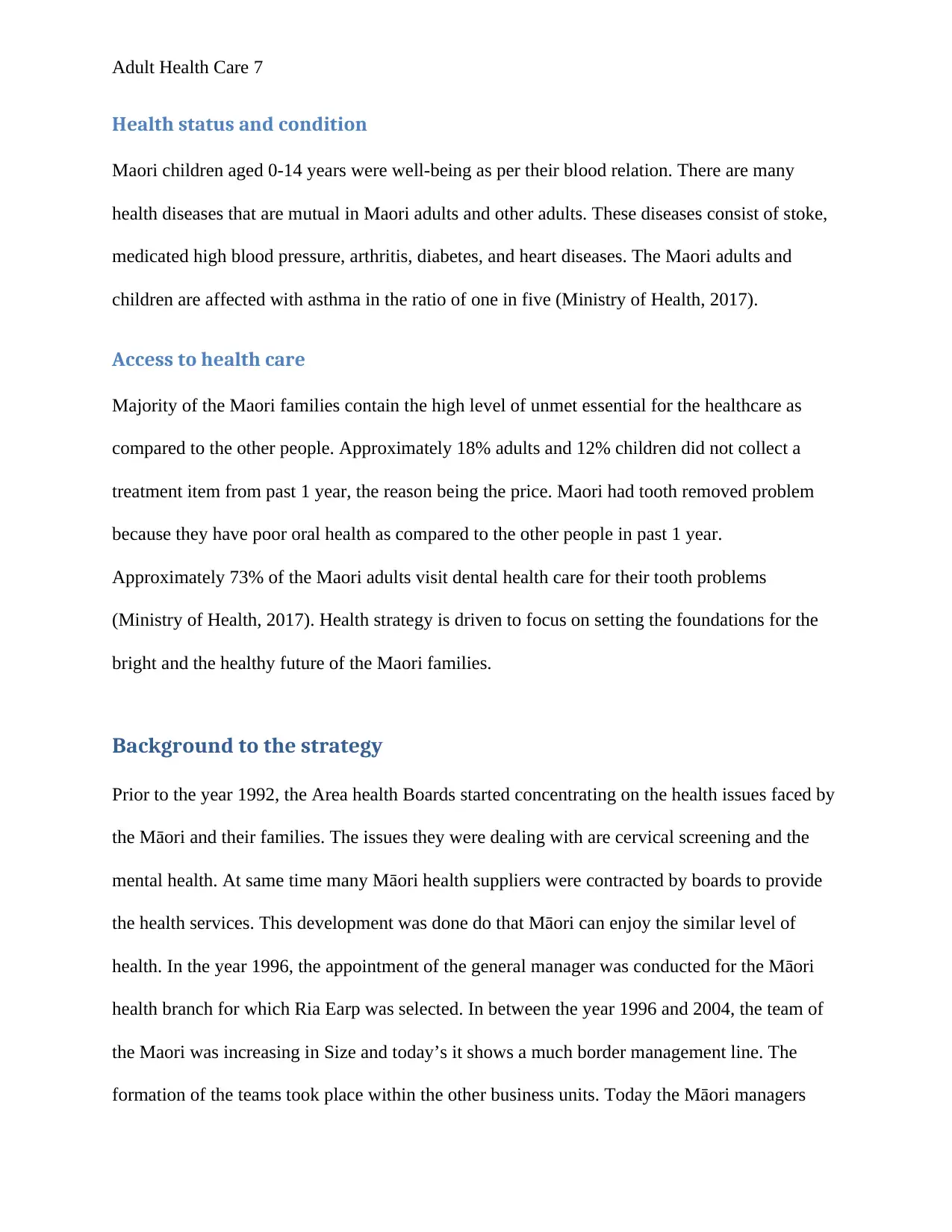
Adult Health Care 7
Health status and condition
Maori children aged 0-14 years were well-being as per their blood relation. There are many
health diseases that are mutual in Maori adults and other adults. These diseases consist of stoke,
medicated high blood pressure, arthritis, diabetes, and heart diseases. The Maori adults and
children are affected with asthma in the ratio of one in five (Ministry of Health, 2017).
Access to health care
Majority of the Maori families contain the high level of unmet essential for the healthcare as
compared to the other people. Approximately 18% adults and 12% children did not collect a
treatment item from past 1 year, the reason being the price. Maori had tooth removed problem
because they have poor oral health as compared to the other people in past 1 year.
Approximately 73% of the Maori adults visit dental health care for their tooth problems
(Ministry of Health, 2017). Health strategy is driven to focus on setting the foundations for the
bright and the healthy future of the Maori families.
Background to the strategy
Prior to the year 1992, the Area health Boards started concentrating on the health issues faced by
the Māori and their families. The issues they were dealing with are cervical screening and the
mental health. At same time many Māori health suppliers were contracted by boards to provide
the health services. This development was done do that Māori can enjoy the similar level of
health. In the year 1996, the appointment of the general manager was conducted for the Māori
health branch for which Ria Earp was selected. In between the year 1996 and 2004, the team of
the Maori was increasing in Size and today’s it shows a much border management line. The
formation of the teams took place within the other business units. Today the Māori managers
Health status and condition
Maori children aged 0-14 years were well-being as per their blood relation. There are many
health diseases that are mutual in Maori adults and other adults. These diseases consist of stoke,
medicated high blood pressure, arthritis, diabetes, and heart diseases. The Maori adults and
children are affected with asthma in the ratio of one in five (Ministry of Health, 2017).
Access to health care
Majority of the Maori families contain the high level of unmet essential for the healthcare as
compared to the other people. Approximately 18% adults and 12% children did not collect a
treatment item from past 1 year, the reason being the price. Maori had tooth removed problem
because they have poor oral health as compared to the other people in past 1 year.
Approximately 73% of the Maori adults visit dental health care for their tooth problems
(Ministry of Health, 2017). Health strategy is driven to focus on setting the foundations for the
bright and the healthy future of the Maori families.
Background to the strategy
Prior to the year 1992, the Area health Boards started concentrating on the health issues faced by
the Māori and their families. The issues they were dealing with are cervical screening and the
mental health. At same time many Māori health suppliers were contracted by boards to provide
the health services. This development was done do that Māori can enjoy the similar level of
health. In the year 1996, the appointment of the general manager was conducted for the Māori
health branch for which Ria Earp was selected. In between the year 1996 and 2004, the team of
the Maori was increasing in Size and today’s it shows a much border management line. The
formation of the teams took place within the other business units. Today the Māori managers
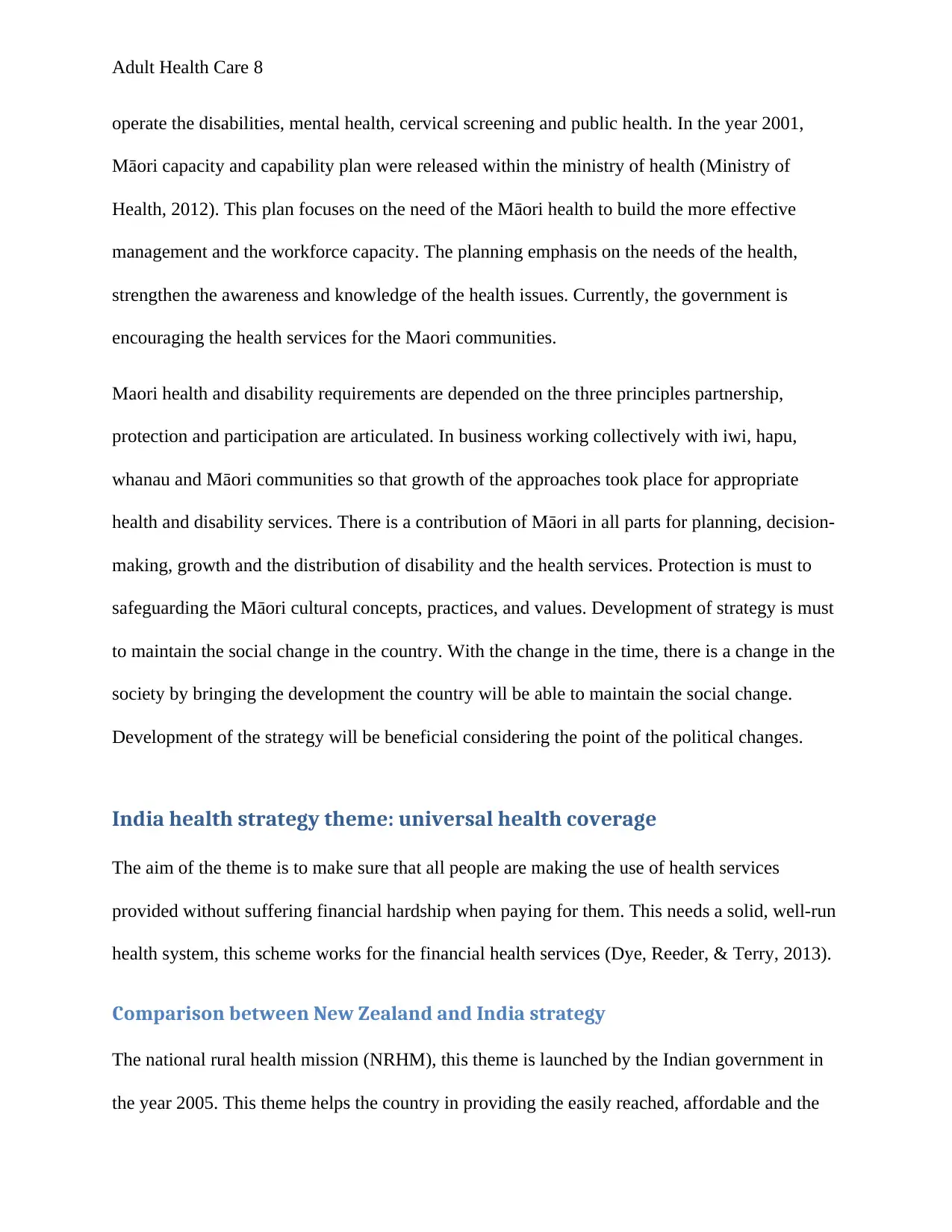
Adult Health Care 8
operate the disabilities, mental health, cervical screening and public health. In the year 2001,
Māori capacity and capability plan were released within the ministry of health (Ministry of
Health, 2012). This plan focuses on the need of the Māori health to build the more effective
management and the workforce capacity. The planning emphasis on the needs of the health,
strengthen the awareness and knowledge of the health issues. Currently, the government is
encouraging the health services for the Maori communities.
Maori health and disability requirements are depended on the three principles partnership,
protection and participation are articulated. In business working collectively with iwi, hapu,
whanau and Māori communities so that growth of the approaches took place for appropriate
health and disability services. There is a contribution of Māori in all parts for planning, decision-
making, growth and the distribution of disability and the health services. Protection is must to
safeguarding the Māori cultural concepts, practices, and values. Development of strategy is must
to maintain the social change in the country. With the change in the time, there is a change in the
society by bringing the development the country will be able to maintain the social change.
Development of the strategy will be beneficial considering the point of the political changes.
India health strategy theme: universal health coverage
The aim of the theme is to make sure that all people are making the use of health services
provided without suffering financial hardship when paying for them. This needs a solid, well-run
health system, this scheme works for the financial health services (Dye, Reeder, & Terry, 2013).
Comparison between New Zealand and India strategy
The national rural health mission (NRHM), this theme is launched by the Indian government in
the year 2005. This theme helps the country in providing the easily reached, affordable and the
operate the disabilities, mental health, cervical screening and public health. In the year 2001,
Māori capacity and capability plan were released within the ministry of health (Ministry of
Health, 2012). This plan focuses on the need of the Māori health to build the more effective
management and the workforce capacity. The planning emphasis on the needs of the health,
strengthen the awareness and knowledge of the health issues. Currently, the government is
encouraging the health services for the Maori communities.
Maori health and disability requirements are depended on the three principles partnership,
protection and participation are articulated. In business working collectively with iwi, hapu,
whanau and Māori communities so that growth of the approaches took place for appropriate
health and disability services. There is a contribution of Māori in all parts for planning, decision-
making, growth and the distribution of disability and the health services. Protection is must to
safeguarding the Māori cultural concepts, practices, and values. Development of strategy is must
to maintain the social change in the country. With the change in the time, there is a change in the
society by bringing the development the country will be able to maintain the social change.
Development of the strategy will be beneficial considering the point of the political changes.
India health strategy theme: universal health coverage
The aim of the theme is to make sure that all people are making the use of health services
provided without suffering financial hardship when paying for them. This needs a solid, well-run
health system, this scheme works for the financial health services (Dye, Reeder, & Terry, 2013).
Comparison between New Zealand and India strategy
The national rural health mission (NRHM), this theme is launched by the Indian government in
the year 2005. This theme helps the country in providing the easily reached, affordable and the
⊘ This is a preview!⊘
Do you want full access?
Subscribe today to unlock all pages.

Trusted by 1+ million students worldwide
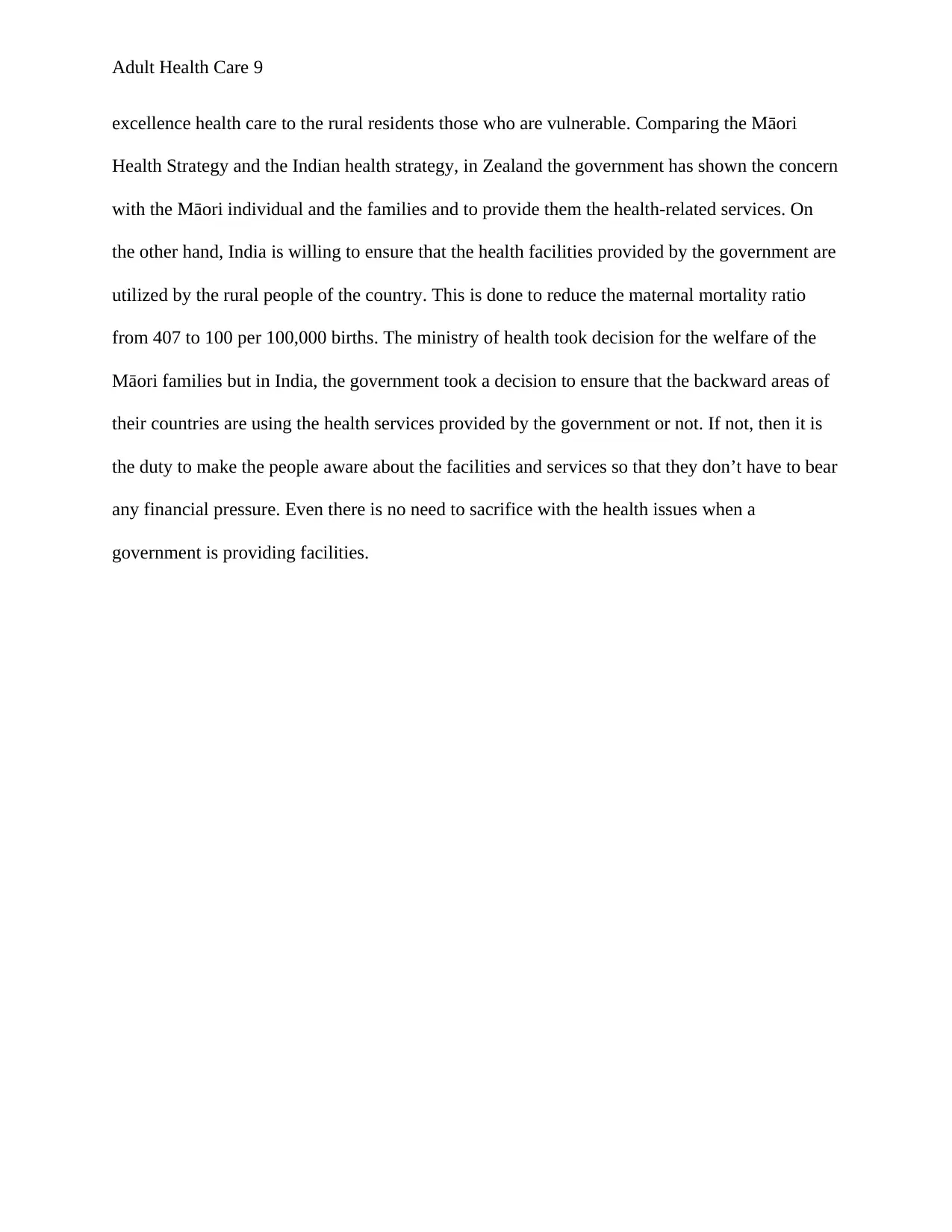
Adult Health Care 9
excellence health care to the rural residents those who are vulnerable. Comparing the Māori
Health Strategy and the Indian health strategy, in Zealand the government has shown the concern
with the Māori individual and the families and to provide them the health-related services. On
the other hand, India is willing to ensure that the health facilities provided by the government are
utilized by the rural people of the country. This is done to reduce the maternal mortality ratio
from 407 to 100 per 100,000 births. The ministry of health took decision for the welfare of the
Māori families but in India, the government took a decision to ensure that the backward areas of
their countries are using the health services provided by the government or not. If not, then it is
the duty to make the people aware about the facilities and services so that they don’t have to bear
any financial pressure. Even there is no need to sacrifice with the health issues when a
government is providing facilities.
excellence health care to the rural residents those who are vulnerable. Comparing the Māori
Health Strategy and the Indian health strategy, in Zealand the government has shown the concern
with the Māori individual and the families and to provide them the health-related services. On
the other hand, India is willing to ensure that the health facilities provided by the government are
utilized by the rural people of the country. This is done to reduce the maternal mortality ratio
from 407 to 100 per 100,000 births. The ministry of health took decision for the welfare of the
Māori families but in India, the government took a decision to ensure that the backward areas of
their countries are using the health services provided by the government or not. If not, then it is
the duty to make the people aware about the facilities and services so that they don’t have to bear
any financial pressure. Even there is no need to sacrifice with the health issues when a
government is providing facilities.
Paraphrase This Document
Need a fresh take? Get an instant paraphrase of this document with our AI Paraphraser
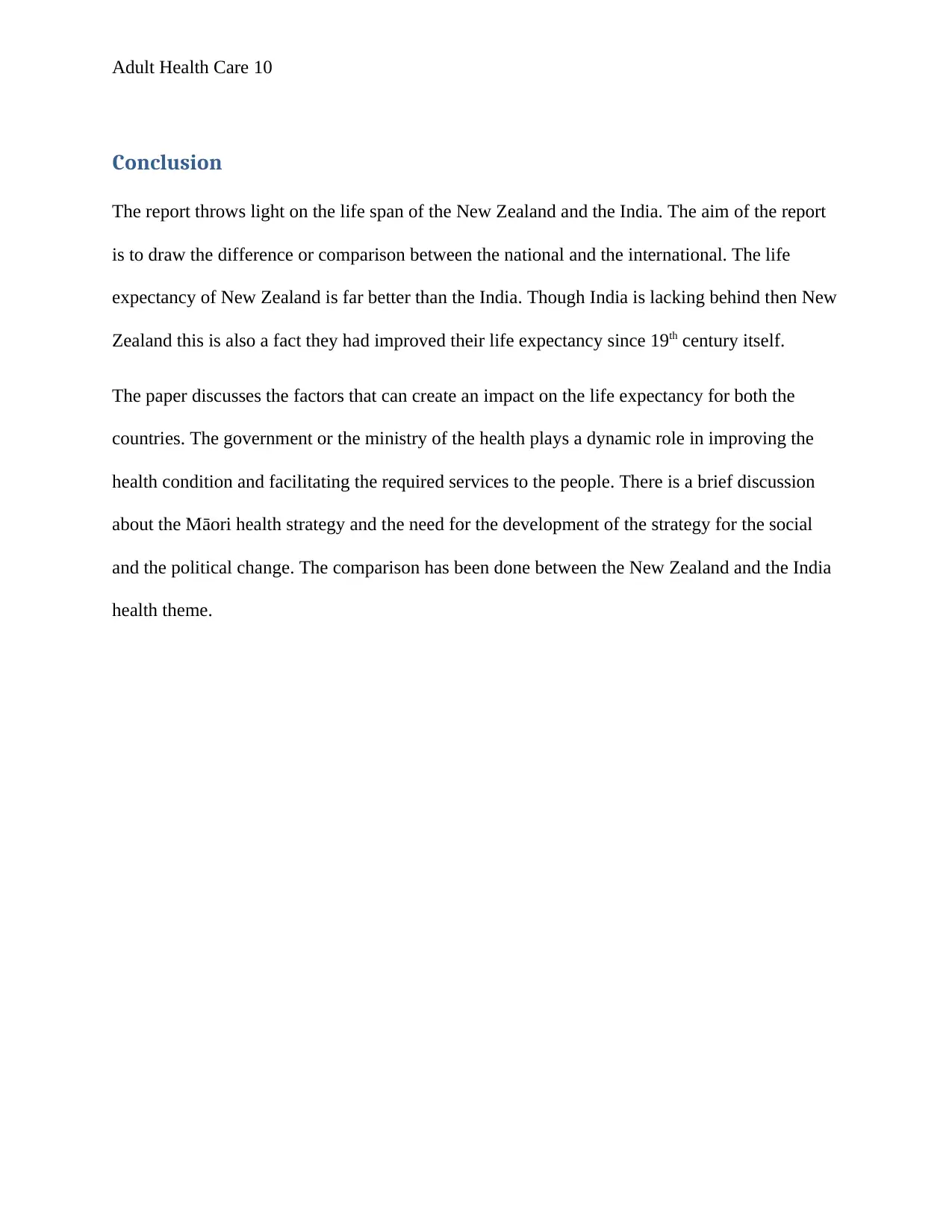
Adult Health Care 10
Conclusion
The report throws light on the life span of the New Zealand and the India. The aim of the report
is to draw the difference or comparison between the national and the international. The life
expectancy of New Zealand is far better than the India. Though India is lacking behind then New
Zealand this is also a fact they had improved their life expectancy since 19th century itself.
The paper discusses the factors that can create an impact on the life expectancy for both the
countries. The government or the ministry of the health plays a dynamic role in improving the
health condition and facilitating the required services to the people. There is a brief discussion
about the Māori health strategy and the need for the development of the strategy for the social
and the political change. The comparison has been done between the New Zealand and the India
health theme.
Conclusion
The report throws light on the life span of the New Zealand and the India. The aim of the report
is to draw the difference or comparison between the national and the international. The life
expectancy of New Zealand is far better than the India. Though India is lacking behind then New
Zealand this is also a fact they had improved their life expectancy since 19th century itself.
The paper discusses the factors that can create an impact on the life expectancy for both the
countries. The government or the ministry of the health plays a dynamic role in improving the
health condition and facilitating the required services to the people. There is a brief discussion
about the Māori health strategy and the need for the development of the strategy for the social
and the political change. The comparison has been done between the New Zealand and the India
health theme.
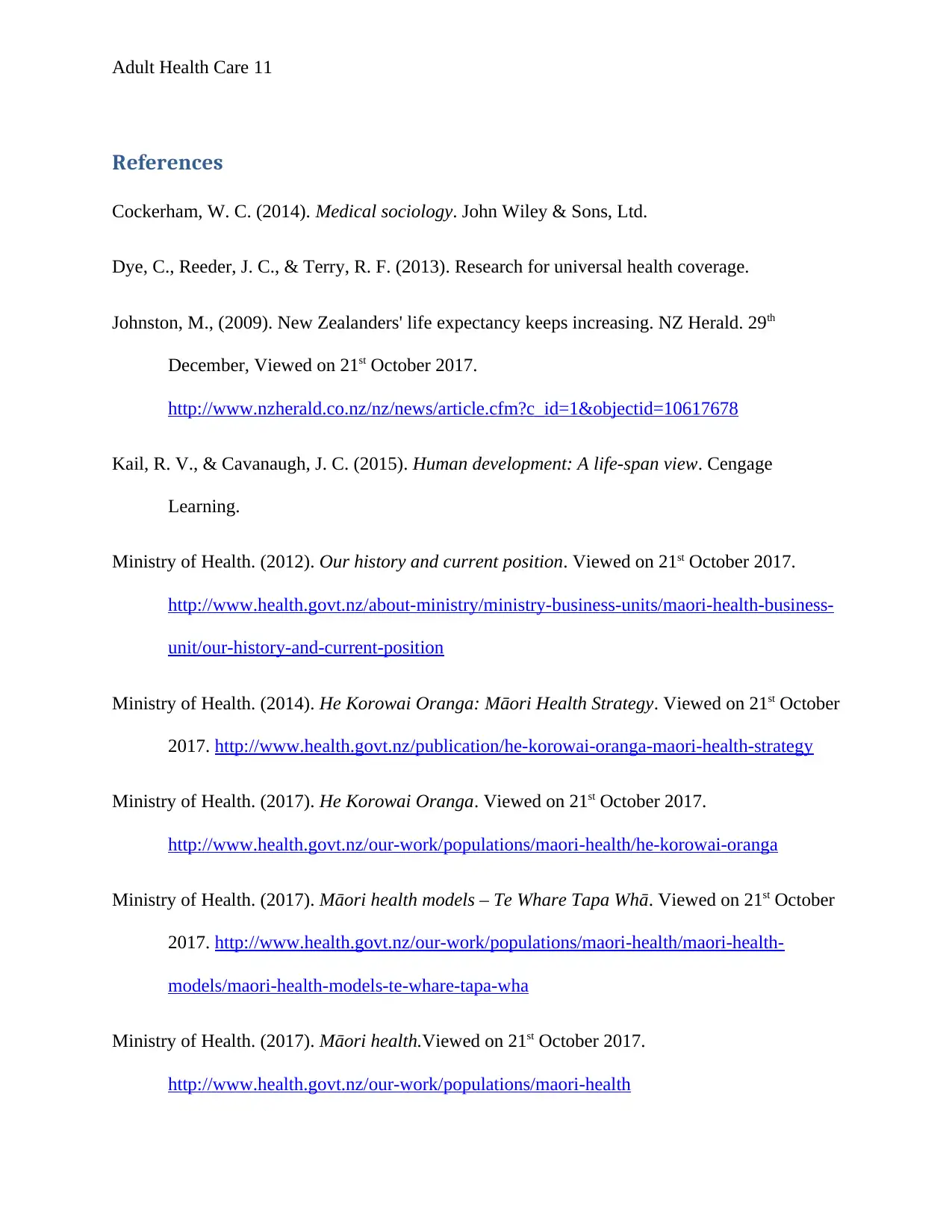
Adult Health Care 11
References
Cockerham, W. C. (2014). Medical sociology. John Wiley & Sons, Ltd.
Dye, C., Reeder, J. C., & Terry, R. F. (2013). Research for universal health coverage.
Johnston, M., (2009). New Zealanders' life expectancy keeps increasing. NZ Herald. 29th
December, Viewed on 21st October 2017.
http://www.nzherald.co.nz/nz/news/article.cfm?c_id=1&objectid=10617678
Kail, R. V., & Cavanaugh, J. C. (2015). Human development: A life-span view. Cengage
Learning.
Ministry of Health. (2012). Our history and current position. Viewed on 21st October 2017.
http://www.health.govt.nz/about-ministry/ministry-business-units/maori-health-business-
unit/our-history-and-current-position
Ministry of Health. (2014). He Korowai Oranga: Māori Health Strategy. Viewed on 21st October
2017. http://www.health.govt.nz/publication/he-korowai-oranga-maori-health-strategy
Ministry of Health. (2017). He Korowai Oranga. Viewed on 21st October 2017.
http://www.health.govt.nz/our-work/populations/maori-health/he-korowai-oranga
Ministry of Health. (2017). Māori health models – Te Whare Tapa Whā. Viewed on 21st October
2017. http://www.health.govt.nz/our-work/populations/maori-health/maori-health-
models/maori-health-models-te-whare-tapa-wha
Ministry of Health. (2017). Māori health.Viewed on 21st October 2017.
http://www.health.govt.nz/our-work/populations/maori-health
References
Cockerham, W. C. (2014). Medical sociology. John Wiley & Sons, Ltd.
Dye, C., Reeder, J. C., & Terry, R. F. (2013). Research for universal health coverage.
Johnston, M., (2009). New Zealanders' life expectancy keeps increasing. NZ Herald. 29th
December, Viewed on 21st October 2017.
http://www.nzherald.co.nz/nz/news/article.cfm?c_id=1&objectid=10617678
Kail, R. V., & Cavanaugh, J. C. (2015). Human development: A life-span view. Cengage
Learning.
Ministry of Health. (2012). Our history and current position. Viewed on 21st October 2017.
http://www.health.govt.nz/about-ministry/ministry-business-units/maori-health-business-
unit/our-history-and-current-position
Ministry of Health. (2014). He Korowai Oranga: Māori Health Strategy. Viewed on 21st October
2017. http://www.health.govt.nz/publication/he-korowai-oranga-maori-health-strategy
Ministry of Health. (2017). He Korowai Oranga. Viewed on 21st October 2017.
http://www.health.govt.nz/our-work/populations/maori-health/he-korowai-oranga
Ministry of Health. (2017). Māori health models – Te Whare Tapa Whā. Viewed on 21st October
2017. http://www.health.govt.nz/our-work/populations/maori-health/maori-health-
models/maori-health-models-te-whare-tapa-wha
Ministry of Health. (2017). Māori health.Viewed on 21st October 2017.
http://www.health.govt.nz/our-work/populations/maori-health
⊘ This is a preview!⊘
Do you want full access?
Subscribe today to unlock all pages.

Trusted by 1+ million students worldwide
1 out of 14
Related Documents
Your All-in-One AI-Powered Toolkit for Academic Success.
+13062052269
info@desklib.com
Available 24*7 on WhatsApp / Email
![[object Object]](/_next/static/media/star-bottom.7253800d.svg)
Unlock your academic potential
Copyright © 2020–2025 A2Z Services. All Rights Reserved. Developed and managed by ZUCOL.





